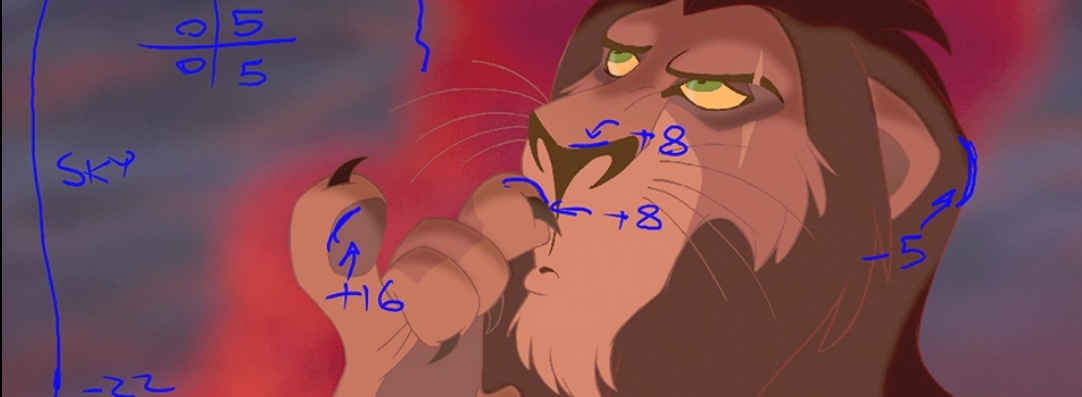James Cameron’s ‘Titanic’ sailed back onto theater screens last week sporting a fresh 3D makeover. This follows last year’s very successful run of ‘The Lion King 3D’. If similar projects continue to make money, we can no doubt expect to see more beloved classics subjected to the 3D treatment – not to mention that even many brand new movies are converted to 3D in post-production. But how exactly are these conversions actually done? The short answer, of course, is: “Computers!” The long answer is a little more complicated.
A couple of articles shed some light on the process. One describes the effort put into converting ‘The Lion King’ to 3D, while the other details the ‘Titanic’ conversion.
As you probably know, 3D images are created by viewing a scene from two viewpoints slightly offset from one another, one that goes directly to the viewer’s right eye and one that goes directly to the left. Movies that are natively produced in 3D use camera rigs that capture both viewpoints on set. (CG animated movies render the two views separately.) However, a movie that was originally shot (or animated) in 2D only has one viewpoint on the action. The second camera view must be created artificially using software that interpolates what that view would look like based on cues in the existing imagery.
Some of this can be automated based on generalized rules about how photographic depth usually works. For example: bright objects are typically closer than dark objects; large objects are often closer than small ones; objects with a hazy focus probably belong in the background, and so forth. Many 3D TVs, Blu-ray players and outboard video processors (like the recently-reviewed 3D-Bee) can do 2D-to-3D conversions in real time, but the results are erratic at best. While these devices will no doubt get better with time, a proper conversion job requires human interaction and guidance.
The technicians, called stereographers, will look at the movie on a frame-by-frame basis and create a “depth map” or “depth script” for each frame that determines which objects get pulled forward, which get pushed backward, and how much in each direction. To convert ‘The Lion King’, 60 artists worked on the movie for four months. ‘Titanic’ was an even bigger project. That one required 450 people and two years of labor, at a reported cost of $18 million.
As described in the ‘Titanic’ article:
Fortunately for those converting feature films, they already know how far away each object on the set was — or was supposed to be — when the movie was made. Productions stills also provide additional information. While this means they don’t have to guess or estimate depth, humans still need to painstakingly assist the software in adding depth information to hundreds of thousands of frames.
Many of the necessary decisions are more artistic in nature than technical. ‘Lion King’ stereographer Robert Neuman explains:
The way I approach depth on the movie is to create a depth score, which is a similar process to the way that a film composer creates a musical score. A film composer uses the rises and falls of the score to echo the emotional content of the film. I try to do the same thing with depth in the movie…
I equate stereoscopic depth to emotional depth. In other words, the shots in the depth script with a value of one get the minimum amount of depth. We’d pull out all the stops on shots with a value of ten by using as much depth as possible. Additionally, if there’s a scene where we’re supposed to feel detached from a character, then I put the character further back into the background. If we’re supposed to feel connected to a character, I bring them further forward. In this way, we’re not using 3D randomly. We’re using 3D as part of the narrative.
The amount of time, effort and skill expended on the project will mark the difference between a tasteful conversion like the above and some of the quick-and-dirty conversions that have plagued recent theatrical releases, such as the notorious ‘Clash of the Titans‘.
Back to that ‘Titanic’ article:
One reason [James] Cameron says that previous 3D conversion efforts have failed is that they were shoehorned into an already busy production schedule, meaning the filmmaker didn’t have the dedicated attention needed to ensure the conversion came out the way they wanted. He also credits his learnings from Avatar with helping him know how to work on this conversion — experience which most other filmmakers don’t have.
Yet when it comes to older films like these, even the best possible conversion will still remain limited by one unavoidable fact: These movies were not originally made with 3D in mind. When James Cameron directed ‘Titanic’, he chose his camera angles, lighting and staging based on the rules for 2D photography, which are not the same as those for 3D photography. Contrast this to a more recent movie that was converted to 3D in post-production, Tim Burton’s ‘Alice in Wonderland‘. Although Burton shot his film in 2D, he planned for 3D from the beginning, and had stereographers on set to advise him on the best camera angles and staging that would maximize the 3D impact. Neither ‘Titanic’ nor ‘The Lion King’ had that benefit. No matter how tastefully done, the conversions for those films were imposed after-the-fact and are, in a way, just the 21st Century’s version of colorizing black & white movies.
[Sources: Collider and Extreme Tech. Thanks to William for the tip on the latter.]





JM
When are they going to start converting movies to 48 frames per second?
Josh Zyber
AuthorThat’s called frame interpolation. Most 120 Hz TVs have that feature now. It makes everything look like a soap opera.
William Henley
I actually have been using frame interpolation a lot lately. My issue has been converting stuff shot at 25fps or 29.97fps down to 24 for Blu-Ray. Yeah, I could take the PAL stuff and simply slow it down to 24fps, but – very rarely – you can actually tell that something is just a tad wrong when watching back. You can also throw frames away, but that kind of creates a studder effect. I find interpolation to be a very good work around, because it throws some frames away, and draws others, to give me the desired frame rate. Interpolation is also EXTREAMELY helpful in video editing if you are slowing down or speeding up video, to keep it from having that “studder” appearence.
Anyways, useful tool that works pretty well when used right.
Eric Hulen
Haha! I think they already do that.
Eric Hulen
Oops I meant most movie theaters projectors run at a 48 or 72 Hz refresh rate.
August Lehe
Hey Josh! Is that why I hated soap operas as a child home sick from school? I guess video tape simulated that effect.
Josh Zyber
AuthorSoap operas have traditionally been shot on video, which until recently had a distinct look very different than film. A big reason for that look was the 60 Hz frame rate capture of the photography. Applying frame interpolation to a film-based source tends to make even feature films look like they were shot on video. Instead of watching a movie, you feel like you’re watching behind-the-scenes footage from the set of the movie.
Modern digital video can be shot at 24 fps and has a much more “film-like” appearance.
Peter Jackson is shooting his new Hobbit movie at 48 fps in order to give it a “hyper-real” appearance. How that will look remains to be seen.
JM
I was asking about Roger Ebert’s love of MaxiVision48.
From his “Why I Hate 3-D (And You Should Too)” article:
“What Hollywood needs is a “premium” experience that is obviously, dramatically better than anything at home, suitable for films aimed at all ages, and worth a surcharge.
For years I’ve been praising a process invented by Dean Goodhill called MaxiVision48, which uses existing film technology but shoots at 48 frames per second and provides smooth projection that is absolutely jiggle-free.
Modern film is projected at 24 frames per second (fps) because that is the lowest speed that would carry analog sound in the first days of the talkies. Analog sound has largely been replaced by digital sound.
MaxiVision48 projects at 48fps, which doubles image quality. The result is dramatically better than existing 2-D. In terms of standard measurements used in the industry, it’s 400 percent better.
That is not a misprint. Those who haven’t seen it have no idea how good it is. I’ve seen it, and also a system of some years ago, Douglas Trumbull’s Showscan. These systems are so good that the screen functions like a window into three dimensions.
If moviegoers could see it, they would simply forget about 3-D.”
JM
I understand that 70mm at 72fps is the limit of the human eye.
William Henley
I can tell you from watching “TRUE” Imax movies (not stuff converted) that it is heads and tails better than 24fps. And if you are watching like a space documentary shot onto an Imax Dome, it really is like being there. No, I agree that higher framerates are great. I haven’t seen 48fps yet, but I can certainly agree that the higher framerate of Imax is significantly better than a regular film.
Josh Zyber
AuthorIMAX is photographed at the same 24 fps rate as regular 35mm. The difference in picture quality there is not due to frame rate, but to the much larger film negative.
William Henley
I’m sorry, I always do this, Imax is 65mm, not 70. I get told this every time, and yet forget again.
There ARE, however, some IMAX-based stuff at 48fps (and I am not refering to 3D). Disney’s Sorin’ Over California is at 48fps.
I remember seeing a documentary on IMAX years ago where they said that IMAX films played at the same speed as what the human eye could see. Just from looking at the article on Wikipedia, that was obviously wrong.
Josh Zyber
AuthorSoarin’ Over California is a theme park attraction, not a standard IMAX film. It was shot in the “IMAX HD” format, which does indeed run at 48 fps. However, only one other movie, called Momentum, was made in this format, plus a small handful of motion-simulator rides.
Normal IMAX movies, such as Space Station or Ultimate Wave Tahiti and whatnot, were shot at 24 fps.
William Henley
Yeah, I was looking at that Imax HD thing. Sounds pretty cool, although I don’t quite understand it. It sounds like the format has already been killed, but it seems with the popularity and growth of IMAX over the past couple of years, that they would look into the format again.
EM
I’ve seen 3D trailers for the 3D Titanic rerelease. If I had been interested in going to see the converted movie, those ads would have turned me off. Some shots of the ship looked OK; but when people were in frame, they looked like flat cardboard standees placed at varying distances from the camera. Maybe the actual 3D movie is of better technical quality; but if so, why sabotage it with this ad campaign?
The trailers for 3D Phantom Menace, on the other hand, actually looked superb—almost enough to convince me they were promoting a worthwhile movie, not that I was really fooled.
What’s the word on these movies’ actual conversion quality?
Aaron Peck
Reading this made me realize that converting movies from 2D to 3D is even a bigger waste of time and resources than I previously imagined.
Thulsadoom
18 million just on converting Titanic?? Is Cameron just determined to spend as much as he can on everything he does? You could make a couple of reasonable small films for that money!! But then, I suppose there’s no guarantee they’d have young girls rushing to see them like DiCaprio in three dimensions… ooh, the excitement…
I’m a huge Star Wars fan (I even enjoy the prequels, despite their flaws) but I still couldn’t be bothered to see TPM in 3D. I’m certainly not paying good money to see Cameron’s cliché ridden attempt at romance again.
Titanic always reminded me of the Oscars scene in Naked Gun 33 1/3, when they read out the absurd ‘art house’ films getting awards. I can’t remember it, but it was something silly like “Ballerina! – The story of a mute one legged ballerina trying to reconnect emotionally with her blind dog, set against the tragic backdrop of the Hindenburg disaster” 😉
JM
Converting to 3D costs $100,000 per minute, and ‘Titanic’ has a lot of minutes.
Bob
Was “Wrath of the Titans” shot in native 3D or converted? I just saw it in 3D, and they did a pretty good job if it was a conversion. Don’t however, confuse that comment with “Clash of the Titans”!!
Josh Zyber
AuthorWrath of the Titans was a conversion. Here’s a handy site to bookmark:
http://realorfake3d.com/
JM
‘Wrath’ was shot in 2D on film, but was designed and edited for 3D conversion.
‘Clash’ was designed and edited for 2D, and given a 3D rushjob.